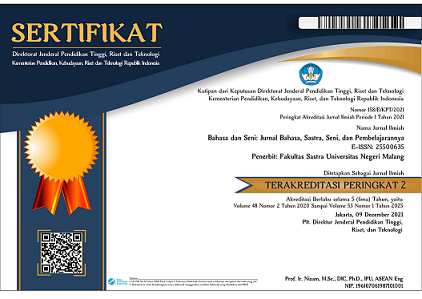The constellation of Lacan’s subject register in Damar Shashangka’s translation of Serat Gatholoco
Abstract
The constellation of Lacan’s subject register in Damar Shashangka’s translation of Serat Gatholoco
Gatholoco is a figure in Serat Gatholoco, a literary work suspected to be written in the early 19th century. The Gatholoco character is said to have a constellation of desires that presents subversive symptoms, positioning Serat Gatholoco as a controversial text at that time. The aim of this study is to describe the constellation of desires in Serat Gatholoco translation from Damar Shashangka, using the economics perspective of the Lacanian subject. This study used the qualitative interpretive method. The result shows Gatholoco as a sublimation of ideas that become the image-subject in the symbolic register, which is a manifestation of alienation symptoms suppressed in the discourse of the Ruler. Naming as a true-born man declared by Gatholoco is a form of active narcissistic desire, a metonymy that connects identification and desire for Gatholoco’s self-hood. The identity of the naming is the substitution of one marker with the Other. Its word is a paternal metaphor, the substitution of the Father’s name (resistance efforts) for the Mother’s desire (primordial existence). This metaphor offers substantial resistance to the Father’s Law (puritan existence). In the end, the nicknames of Gatholoco are a form of the narcissistic desire of the author.
Keywords: Gatholoco, a constellation of desires, psychoanalysis
Konstelasi subjek register Lacanian dalam Serat Gatholoco terjemahan Damar Shashangka
Gatholoco ialah tokoh yang terdapat dalam Serat Gatholoco yang diperkirakan ditulis pada awal abad ke-19. Tokoh Gatholoco dikisahkan memiliki konstelasi hasrat yang menyajikan gejala subversif sehingga Serat Gatholoco menjadi teks yang kontroversial pada zamannya. Tulisan ini bertujuan mendeskripsikan konstelasi hasrat dalam Serat Gatholoco terjemahan Damar Shashangka ditilik dari ekonomi subjek register Lacanian. Metode kualitatif interpretatif digunakan dalam penelitian ini. Hasil penelitian menunjukkan Gatholoco sebagai sublimasi gagasan yang menjadi citra-subjek dalam register simbolik yang merupakan manifestasi gejala alienasi yang ditekan dalam diskursus Sang Penguasa. Penamaan seperti lelaki sejati yang dideklarasikan Gatholoco merupakan bentuk hasrat narsistik aktif, metonimia yang menghubungkan identifikasi dan hasrat atas kedirian Gatholoco. Identitas atas penamaan tersebut merupakan substitusi satu penanda dengan Liyan. Kata tersebut merupakan metafora yang bersifat paternal, substitusi nama Ayah (upaya resistensi) demi hasrat sang Ibu (eksistensi primordialitas). Metafora tersebut menawarkan perlawanan secara subtansial terhadap Hukum Sang-Ayah (eksistensi puritan). Pada akhirnya, nama-nama sebutan dari identitas Gatholoco merupakan bentuk hasrat narsistik pengarang serat itu sendiri.
Kata kunci: Gatholoco, konstelasi hasrat, psikoanalisis
Full Text:
PDFReferences
Abimanyu, P. (2014). Mistik kejawen : Menguak Rahasia Hidup Orang Jawa. Palapa.
Asmara, A. (2013). Dimensi Alam Kehidupan dan Manunggaling KawulaGusti dalam Serat Jatimurti. Atavisme, 16(2), 153–167. https://doi.org/10.24257/atavisme.v16i2.90.153-167
Bogdan, R., & Biklen, S. (1992). Qualitative Research for Education. MA: Allyn and Bacon.
Bracher, M. (2009). Jaques Lacan, Diskursus dan Perubahan Sosial: Pengantar Kritik-Budaya Psikoanalisis (G. Admiranto (ed.)). Jalasutra.
Cambara, H. C. (2018). Konstelasi Hasrat dalam Serat Gatholoco. Institut Seni Budaya Indonesia.
Day, T. (2007). “Self” and “Subject” in Southeast Asian Literature in the Global Age. Asian and Pacific Cosmopotitans, 19–20.
Endraswara, S. (2005). Tata Pemerintahan Jawa dalam Serat Wejangan Wewarah Bantah Cangkriman Piwulang Kaprajan. Kejawen, 1(1), 5–48.
Furqon, S., & Busro, B. (2018). Serat Gatholoco: Tubuh Menggugat Agama. Religious: Jurnal Studi Agama-Agama Dan Lintas Budaya, 2(1), 15. https://doi.org/10.15575/rjsalb.v2i1.2213
Gunasasmita, R. (2009). Kitab Primbon Jawa Serbaguna. Narasi.
Haq, Z. (2013). Ajaran Makrifat: Penuntun Jiwa Yang Jawa. Kreasi Wacana.
Lacan, J. (1978). Seminar XI: The Four Fundamental Concepts of Psychoanalysis. Norton.
Mislikhah, S. (2014). Kesantunan Berbahasa. Ar-Raniry, International Journal of Islamic Studies, 1(2), 285. https://doi.org/10.20859/jar.v1i2.18
Mulder, N. (1984). Kebatinan dan Hidup Sehari-hari Orang Jawa. Gramedia.
Musman, A. (2021). Agama Ageming Aji: Menelisik Akar Spiritualisme Jawa. Anak Hebat Indonesia.
Nugroho, K. S. S. (2020). Laku & Ngelmu Spiritual Jawa. Lakeisha.
Ratna, N. K. (2013). Metode Penelitian Sastra. Pustaka Pelajar.
Rozikin, C. (2007). Serat Suluk Gatholoco Sebuah Sinergi Kultural antara Islam dan Jawa: Suatu Kajian Resepsi Sastra.
Rush, J. R. (2012). Candu Tempo Doeloe: Pemerintah, Pengedar, dan Pecandu 1860-1910. Komunitas Bambu.
Shashangka, D. (2010). Serat Gatholoco.
Sudarwati & Jupriyono, D. (1997). Betina, Wanita, Perempuan: Telaah Semantik Leksikal, Semantik Historis, Pragmatik. FSU in the Limelight, 5(1).
Sumardjo, J. (2014). Estetika Paradoks. Kelir.
Sumarlam, D. P., & Pamungkas, S. (2014). Pemahaman dan Penggunaan Cangkriman oleh Masyarakat Jawa Sekarang. Proceedings International Seminar Language Maintenance and Shift IV, 73.
Sumarsih, S. (2021). Unsur-Unsur Kontroversial dan Penghinaan Terhadap Agama Islam dalam Suluk Gatholoco. Jumantara: Jurnal Manuskrip Nusantara, 12(1), 125. https://doi.org/10.37014/jumantara.v12i1.1142
Surpi, N. K. (2020). Kejawen: Kearifan yang Adiktif. Genta Hredaya, 4(2), 101–111.
Suseso, F. M. (2005). Pijar-pijar Filsafat dari Gatholoco ke Filsafat Perempuan, dari Adam Muller ke Postmodernisme. Kanisius.
Ulum, M. S. (2019). Serat Gatholoco Dalam Kajian Poskolonial. Asketik, 3(2), 143–150. https://doi.org/10.30762/ask.v3i2.1688
Wibowo, S. (1993). Cangkriman. Mendikbud.
DOI: http://dx.doi.org/10.17977/um015v50i12022p98
Refbacks
- There are currently no refbacks.

This work is licensed under a Creative Commons Attribution 4.0 International License.

Dear Sir/Madam
We appreciate your continued confidence and trust in Bahasa dan Seni: Jurnal Bahasa, Sastra, Seni, dan Pengajarannya (JBS). In order to enhance the service, readability, and quality of JBS publications, we will be transitioning to a new website, https://citeus.um.ac.id/jbs, in collaboration with Digital Commons (Elsevier) starting in July 2024.
Sincerely
Yusuf Hanafi
(Editor in chief)
















2.png)